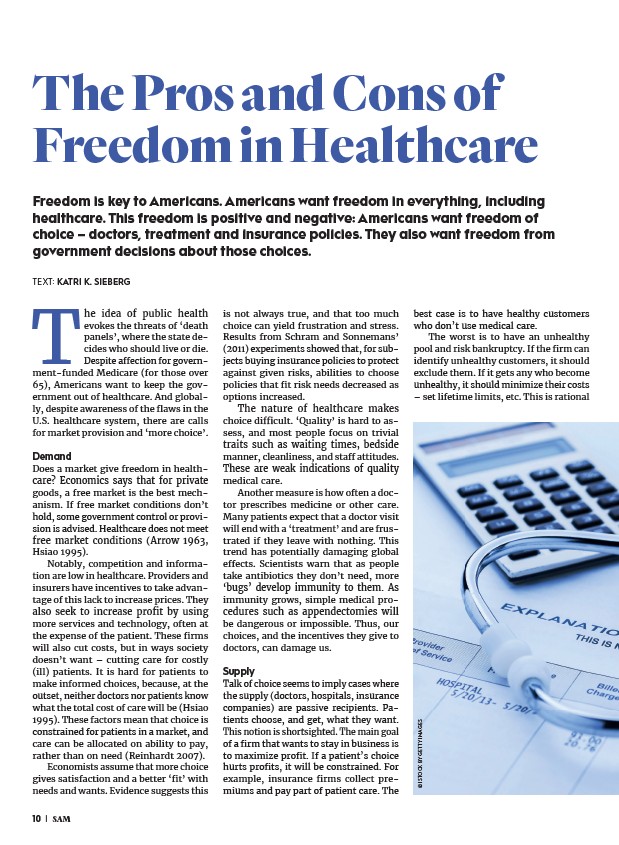
The Pros and Cons of
Freedom in Healthcare
Freedom is key to Americans. Americans want freedom in everything, including
healthcare. This freedom is positive and negative: Americans want freedom of
choice – doctors, treatment and insurance policies. They also want freedom from
government decisions about those choices.
TEXT: KATRI K. SIEBERG
The idea of public health
evokes the threats of ‘death
panels’, where the state decides
who should live or die.
Despite affection for government
funded Medicare (for those over
65), Americans want to keep the government
out of healthcare. And globally,
despite awareness of the flaws in the
U.S. healthcare system, there are calls
for market provision and ‘more choice’.
Demand
Does a market give freedom in healthcare?
Economics says that for private
goods, a free market is the best mechanism.
If free market conditions don’t
hold, some government control or provision
is advised. Healthcare does not meet
free market conditions (Arrow 1963,
Hsiao 1995).
Notably, competition and information
are low in healthcare. Providers and
insurers have incentives to take advantage
of this lack to increase prices. They
also seek to increase profit by using
more services and technology, often at
the expense of the patient. These firms
will also cut costs, but in ways society
doesn’t want – cutting care for costly
(ill) patients. It is hard for patients to
make informed choices, because, at the
outset, neither doctors nor patients know
what the total cost of care will be (Hsiao
1995). These factors mean that choice is
constrained for patients in a market, and
care can be allocated on ability to pay,
rather than on need (Reinhardt 2007).
Economists assume that more choice
gives satisfaction and a better ‘fit’ with
needs and wants. Evidence suggests this
is not always true, and that too much
choice can yield frustration and stress.
Results from Schram and Sonnemans’
(2011) experiments showed that, for subjects
buying insurance policies to protect
against given risks, abilities to choose
policies that fit risk needs decreased as
options increased.
The nature of healthcare makes
choice difficult. ‘Quality’ is hard to assess,
and most people focus on trivial
traits such as waiting times, bedside
manner, cleanliness, and staff attitudes.
These are weak indications of quality
medical care.
Another measure is how often a doctor
prescribes medicine or other care.
Many patients expect that a doctor visit
will end with a ‘treatment’ and are frustrated
if they leave with nothing. This
trend has potentially damaging global
effects. Scientists warn that as people
take antibiotics they don’t need, more
‘bugs’ develop immunity to them. As
immunity grows, simple medical procedures
such as appendectomies will
be dangerous or impossible. Thus, our
choices, and the incentives they give to
doctors, can damage us.
Supply
Talk of choice seems to imply cases where
the supply (doctors, hospitals, insurance
companies) are passive recipients. Patients
choose, and get, what they want.
This notion is shortsighted. The main goal
of a firm that wants to stay in business is
to maximize profit. If a patient’s choice
hurts profits, it will be constrained. For
example, insurance firms collect premiums
and pay part of patient care. The
best case is to have healthy customers
who don’t use medical care.
The worst is to have an unhealthy
pool and risk bankruptcy. If the firm can
identify unhealthy customers, it should
exclude them. If it gets any who become
unhealthy, it should minimize their costs
– set lifetime limits, etc. This is rational
© ISTOCK BY GETTY IMAGES
10 | SAM